Dispelling the product feedback myths that are preventing you from taking action to unlock growth, happy customers & efficient teams
Introduction: The long arm of product feedback

Is your Support team drowning in feature requests with no idea what to do with them? Does your Product team struggle to gather the feedback and lack the context behind customer ideas? Do you only hear from a few of your loudest customers with requests that aren’t aligned with your vision of the product? Do your customers feel that their ideas and feedback are lost in a black hole? Is Customer Success sandwiched between the customer and product teams? Do you have product feedback scattered across spreadsheets, people’s desks, and in people’s heads?
Chances are at least one of these is affecting the growth and productivity of your organization every single day.
Unfortunately, when your teams try to solve this on their own or with software not built for the job it leads to knee jerk solutions, reminders that are soon forgotten, and even more manual processes and areas in your business. Your product feedback is stored and simply forgotten about.
The movement has to come from the top down, it has to come from YOU.
We’ve always done it this way….
Benjamin Franklin (maybe) once said, “Don’t put off until tomorrow what you can do today”. Yet SaaS companies struggle to harness one of their biggest business opportunities day in and day out….
…PRODUCT FEEDBACK
Product feedback, ideas and feature requests will come into your organization regardless of how you choose to handle it. As a CEO or VP, you essentially have 2 options:
Option 1: Carry on as normal, largely ignore feedback and feature requests and let every team handle it how they wish. This leads to frustrated teams and customers and a lot of time, effort and money spent on the “wrong” things.
Option 2: Harness feedback and feature requests by putting a few simple processes in place to de-risk roadmapping decisions, spot new market opportunities, improve efficiency between teams and give your customers the experience they deserve.
Want to be a leading SaaS company in your space? Then go with option 2 and these are just some of the benefits:
-
Internal product battles will be a thing of the past;
-
Customer experience will be majorly improved;
-
Sales will increase and lost prospects can be reactivated;
-
You’ll have room to breathe, think about things, and act strategically;
-
Oh, and you’ll have a better product too!
So let’s dispel the most common myths when it comes to dealing with product feedback and feature requests in SaaS…
Myths dispelled
Click the links to hop straight to the content.
Myth #1: The current feedback process works so we aren’t in a hurry
Myth #2: A new process will be hard to implement and will cause too much disruption in our teams or we don’t have time to implement this right now
Myth #3: Our feedback spreadsheet works great or we use Trello or UserVoice for feedback and feature requests
Myth #4: If we welcome feedback and feature requests we have to build more things
Myth #5: A feedback process means building everything our customers ask for or they will be upset
Myth #6: We don’t get enough product feedback to need a solution or process
Myth #7: We get too many feature requests and pieces of product feedback - why would we want more!?
Myth #8: We don’t have the budget to solve this
Myth #9: We don’t know enough about product feedback processes to implement something like Receptive
Myth #1: The current feedback process isn’t broken so we aren’t in a hurry
Most businesses use Trello, spreadsheets, JIRA and emails to manage product feedback and feature requests. These are OK to start with but as you and your customer base grows, these solutions do not scale. This means:
-
A lot of your teams’ time being spent on manually collating and trying to understand the data;
-
Customers feel that any feedback or feature request they make disappears into a black hole;
-
Data will be spread throughout your organization so it’s hard to get to and use in any meaningful way;
-
The data that you do have is out-of-date and unprioritized;
-
Any prioritization that is done, will usually involve your product team - this is guess work and usually done on gut feeling or by using a very laborious and manual process where weightings/ scores are assigned to requests;
-
There’s not a uniform way to gather context around a feature request or piece of feedback so useful information such as the priority, use cases and workarounds are missing;
-
You don’t understand who the feedback has come from or how important it is;
-
Keeping a tally on a spreadsheet can lead to product decisions being based on “votes”. The most popular requests are rarely the ones you should be focussing on;
-
The lack of up-to-date information leads to decisions based on gut-feeling, the loudest customers, pushy sales team members or vocal managers.
Receptive gives you a “system of record” and process for all your feedback & feature requests. Users can prioritize on an ongoing basis, your customers have a market-leading experience, and you capture the data you need. The powerful reporting allows you to answer your burning business questions in one-click. A few examples are:
-
What do my enterprise/mid-market/SMB accounts want?
-
What trends has our CS team identified?
-
What do our Sales teams in the Southeast region need to close more deals?
-
What discussions is our CAB having about our product?
-
What do our customers need to get value out of the product?
-
What quick wins can we build and what would the impact be?
You can be up and running within hours too:
“It took Sonar all of 20 minutes to integrate with Receptive. It was quick and painless”
Learn more by checking out myth #2 below.
Learn more from our industry-leading resources
The One Thing Trello Can’t Do
Product Manager’s Shouldn’t Prioritize Feature Requests
Roadmap poison: Voting for feature requests
Roadmap poison: Building features for prospects
Myth #2: A new process will be hard to implement and will cause too much disruption in our teams or we don’t have time to implement this right now
With your current process, you will be losing hours and hours of time across your teams every single day. You will have:
-
Support dealing with tickets about feature requests.
-
Customer Success trying to get feedback updates from product teams.
-
Sales teams shoulder tapping about new requests to close deals.
-
Product teams manually collating and trying to make some sense of all the information…
…you can’t afford NOT to take action.
The Receptive javascript integration usually takes about 20 minutes (see this case study and this one) to set up, and you can add on some auto tagging configuration at the start which takes a bit more time. (Most of our customers wait until they know what kind of data they want before setting up auto tagging.)
The thing that usually takes the longest is pulling together your backlog and populating a few items on your roadmap and latest releases (which is all optional). The CSV import is quick in Receptive - but getting the data together can occasionally take the most time.
We have a Product Feedback Policy template which takes care of most of the upfront customer and team onboarding. After launch, we’ll work with your product team to make sure they get the most out of Receptive, but upfront they don’t need to lift a finger.
In summary, if your “champion” spends an afternoon on Receptive, you can get everything ready to go and then launch as soon as the integration is released. Or, if you want to get started immediately, just start inviting in your teams + customers and let them populate your account for you!
Here’s our Getting Started Guide with all of the detailed steps, and when you become a Receptive customer we’ll send over a personalized checklist based on your plan and use case.
The best part is the ROI is built directly into your Receptive Dashboard so you can see the impact it has across your organization at anytime.
» ROI calculator - find out how much you will save when you implement Receptive
Example ROI dashboard:

Myth #3: Our feedback spreadsheet works great or we use Trello or UserVoice for feedback and feature requests
If your spreadsheet, Trello or UserVoice customer forum is working for you right now, then that’s great but…
…when you are a scaling or Enterprise B2B SaaS organization, you need a solution that is built just for you, so you can scale your product feedback & feature request process.
Here are some resources which will help you know when the time is right:
How do you Know When to Scale your SaaS Product Feedback Process?
The One Thing Trello Can’t Do
5 Reasons to Choose Receptive over UserVoice
When you’re ready, just book a call with our experienced Customer Success Team who will give you market leading advice
Myth #4: If we welcome feedback and feature requests, we have to build more things and our teams are already stretched
No. Absolutely not. It’s not about building more, it’s about building more of the right improvements and features into your products.
Your SaaS organization will be receiving product feedback and feature requests daily anyway.
Receptive allows you to embrace this information and actually use it to improve your team efficiency and customer experience, ensuring everyone is working on the right things.
By welcoming feedback & feature requests you:
-
Have a channel to get all feedback and feature requests in one place.
-
Product teams know where to access the data to de-risk roadmapping decisions and spot new opportunities.
-
You can balance the Voice of the Customer with strategic product development.
-
You can easily keep customer and customer-facing teams in the loop so feedback doesn’t disappear into a black hole.
-
You know you’re working with relevant and up-to-date information so time, effort and money is spent on product areas that directly align with your company goals.
A Product Feedback Policy is an excellent way to outline how your organization gathers and uses feedback and feature requests. There’s some more information, examples from leading SaaS companies, and a free template here. If you become a Receptive customer, your Product Feedback Policy is one of the first things your Customer Success Manager will implement for you.
Myth #5: A feedback process means building everything our customers ask for or they will be upset
You will be receiving ideas, product feedback and feature requests from your customers anyway. Right now the data will be going to your customer-facing teams and clogging up your support channel or getting lost in emails and spreadsheets:
“One of the immediate benefits was the drastic decrease in support tickets that users sent in with requests on. In fact, Sonar used to get five to ten request tickets a day, rushing support off their feet. After Receptive, that dropped to just one. One a month.”
Customers will often not receive updates which leaves them feeling like their voice is not being heard and their feedback is just disappearing into a black hole; they deserve more.
Research shows that companies who handle customer feedback and development well have a huge competitive advantage.
Receptive allows you to supercharge your customer experience so your users will be more likely to stick around, buy more software from you and become advocates for what you do. You can no longer afford to ignore the Voice of the Customer as the SaaS model means it’s all too easy to move elsewhere if your vendor doesn’t meet your needs.
A feedback process DOES NOT mean building everything your customers ask for! Quite the opposite. With Receptive you will:
-
Have a Product Feedback Policy in place to set customers’ expectations about how you collect and use their feedback and feature requests.
-
Be able to give customers the right level of transparency into your product process. Receptive gives you full control to collect & prioritize requests on behalf of customers through customer-facing teams or you can open up a customer feedback portal.
-
Keep customers in the loop so they automatically receive updates as requests change status (this is optional).
-
Share a customer-facing roadmap and release log (again, these are optional).
-
With some process and transparency feature requests and product feedback from customers are no longer a political or emotional transaction between your users and customer-facing teams. Customers know their voice is heard and respect the decisions you make.
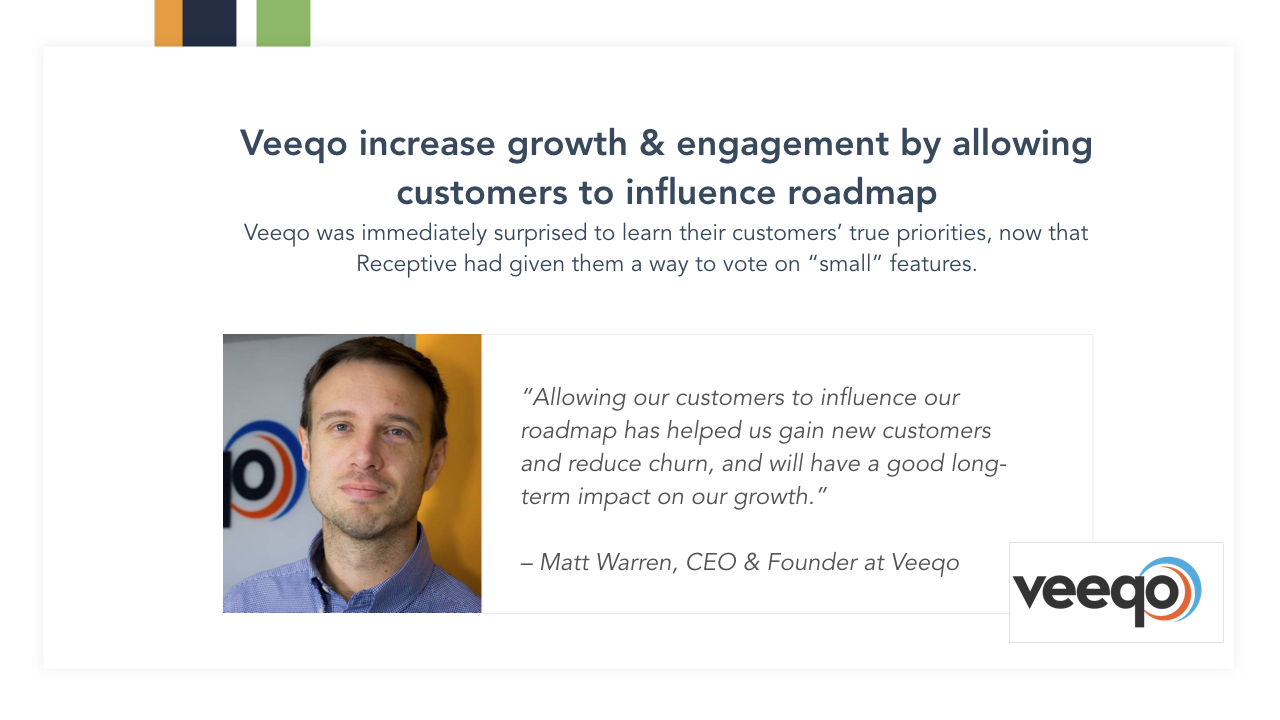
Learn more from our industry-leading resources
Never prioritize your roadmap based on customer feedback
Building a SaaS product - it’s not a democracy
Webinar: How to grow your SaaS by saying “no” to feature requests
How we say “no” to feature requests
Myth #6: We don’t get enough product feedback to need a solution or process
If you are a small business or startup, you can use a spreadsheet or something like Trello for feedback and feature requests.
If you are a scaling or Enterprise SaaS company, the chances are you don’t realize just how much feedback data is spread across the organization that is simply going to waste.
Even with a small number of customers, you can end up with your Customer Success and Support teams fielding a lot of feedback which they don’t know how to handle well or pass onto your product teams.
Customer feedback is also only one stream of data that informs product decisions - feedback and feature requests from the market and your internal teams also need to be considered:
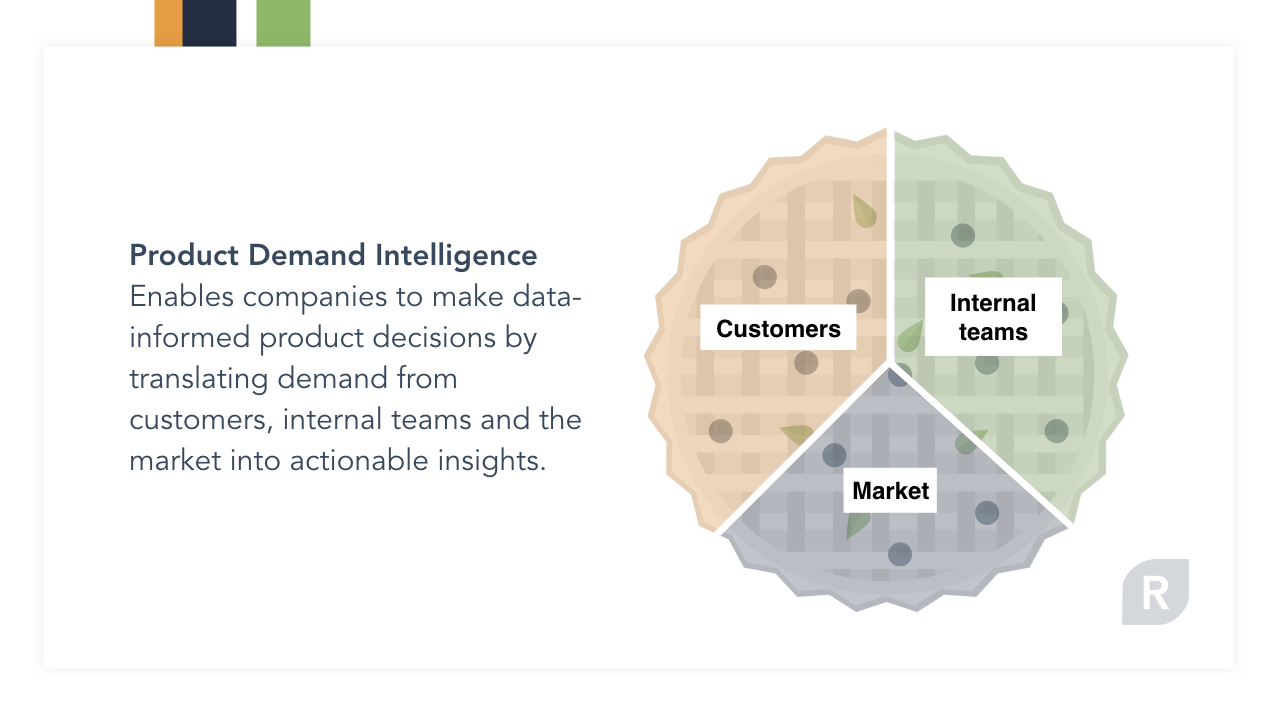
You will also find that information from these different segments will be more relevant to you at different times depending on your current strategic goals. By collecting all of this information in one place, you can slice and dice it, just when you need it. Perfect.
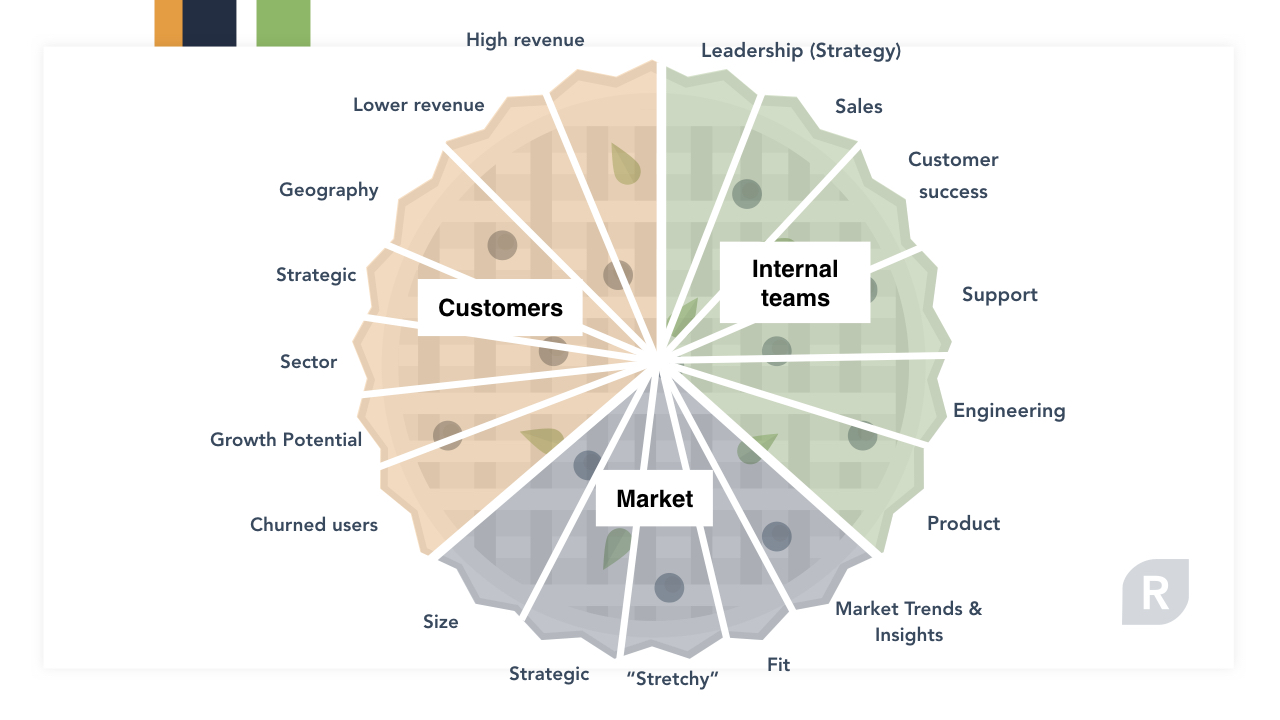
Finally, opening a feedback channel encourages collaboration with customers and across teams. If people have been used to their suggestions disappearing into a black hole, Receptive will give them their voice back through our nifty engagement features which you can learn about in this short webinar.
Learn more from our industry-leading resources
Whitepaper: How SaaS companies use Product Strategy
At Scale Webinar: How to Make Customers Happy With Product Feedback
Webinar Series: Roadmap Fuel (product feedback from your customers, teams and the market)
Myth #7: We get too many feature requests and pieces of product feedback - why would we want more!?
Creating a process and channel for your product feedback and feature requests allows you to use and understand the feedback data you already have. Not only that, but using Receptive sets you up for life - you no longer have to worry about being overwhelmed with the information you receive.
A simple process means you can use feedback data and feature requests to your advantage, keep everyone aligned, and be building improvements and features into your products that have a massive impact on retention, upsell and growth.
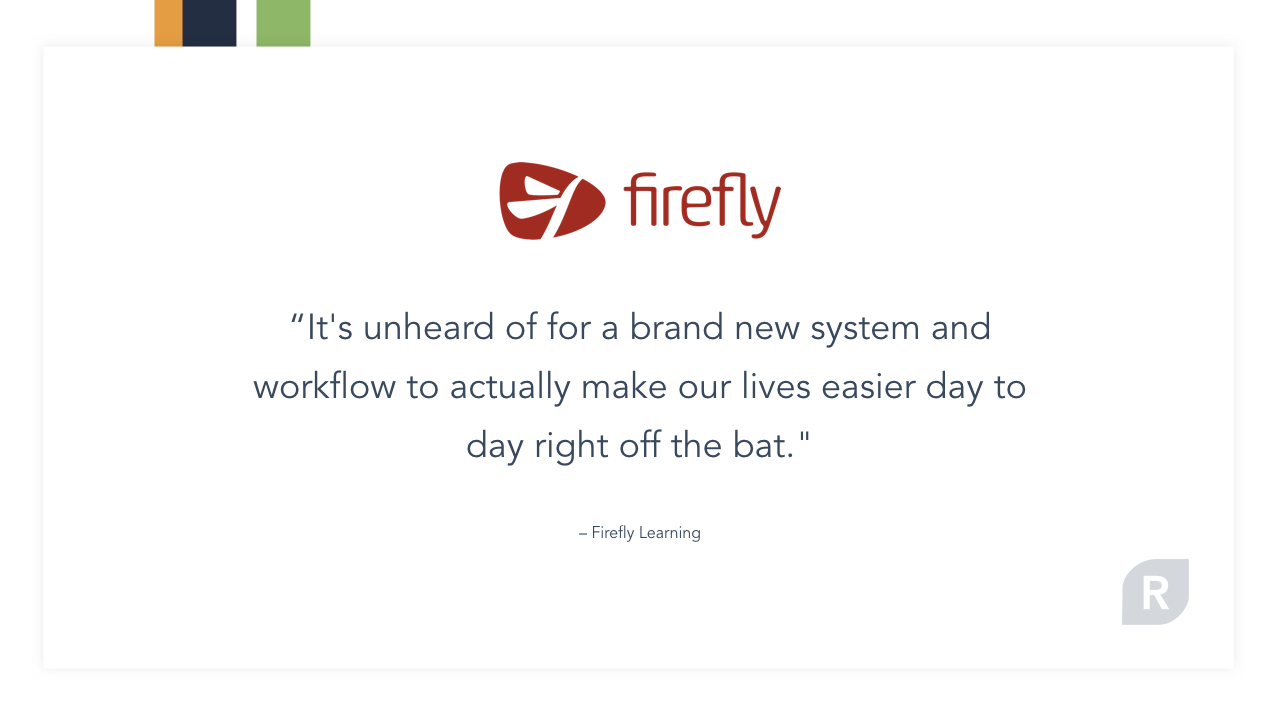
Receptive is the only product built especially for scaling and Enterprise B2B SaaS companies and our industry leading Customer Success team will be with you every step of the way. We produce a Flight Plan Series of content to share best practices and facilitate sessions with new and older Receptive users:
Flight Plan Webinars
How to harness product feedback at scale
The Feedback Loop Episode 1: Magnus Health & Commissions Inc
The Feedback Loop #2: SS&C Advent Black Diamond & DaVita Kidney Care
Myth #8: We don’t have the budget to solve this
Hours and hours are wasted on manual process around capturing and trying to understand product feedback and feature requests every single day. The implications for your revenue and growth are huge because you are likely to:
-
Have people working on things that don’t align with your company goals.
-
Be building features for prospects that never sign a deal.
-
Be building for loud customers, free triallers, or demanding managers.
-
Have frustrated customers who go elsewhere.
-
Have shoulder tapping between teams who need to find out the status on requests for customers or prospects.
-
Have roadmaps being railroaded by pet projects.
-
Have a lot of unprioritized and out-of-date information that needs to be unpicked by your product teams.
The ROI of Receptive is immediate and powerful. ROI calculations are built into the product itself which you can access at anytime.
Before you are a customer, you can use our our ROI calculator.
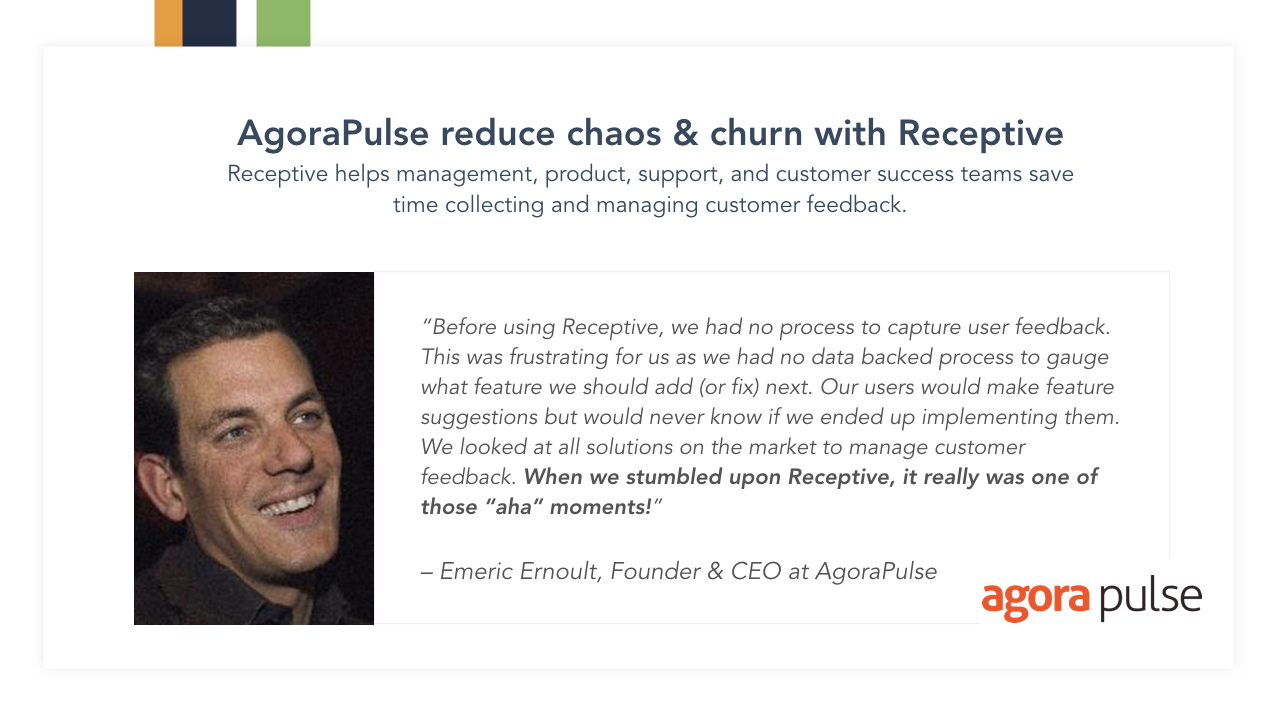
Myth #9: We don’t know enough about product feedback processes to implement something like Receptive
Receptive is a renowned market leader in Product Demand Intelligence.
When you become a customer, you get access to a world class Customer Success team, and best practices and processes. We become your ally in rolling out a successful product feedback process across your whole organization.
We also run regular research projects, content designed just for our customers and participate in many industry events and speaking engagements. If you want to be at the cutting edge of SaaS and product feedback, we are the partner for you.
Want some advice on your current product feedback & feature request process?
You can contact our highly experience Customer Success team here to find out how we can help you become a market leading SaaS organization.
Tl;dr
-
A good process for product feedback can start NOW - it will reduce churn, improve team collaboration, and get everyone working on things that really count.
-
The “old”, manual way of dealing with product feedback and feature requests doesn’t scale, frustrates your teams and customers, and is a huge waste of time, effort & money.
-
Product feedback is a huge opportunity for the growth of your SaaS organization and those that take it seriously are becoming the market leaders.
-
You can’t afford to waste resources building “improvements” and features to appease management, your sales team, or your most vocal customers.
-
Feedback data is already in your organization and it’s coming to you anyway. A few simple steps is all it takes to make the information work for you, not against you.




